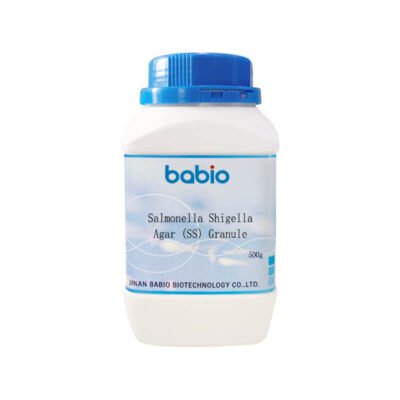Description
Plate Count Agar Granule: Comprehensive Product Description
Plate Count Agar Granule is a versatile medium designed for the cultivation of bacteria and the enumeration of microorganisms in various samples, including water, sewage, faeces, and food products. This medium is formulated to meet the requirements set by organizations such as APHA, PHLS, and ISO, making it ideal for use in microbial testing across multiple industries, from food safety to environmental monitoring. It provides accurate and consistent results, ensuring the reliable quantification of microbial populations in a wide range of samples.
Composition and Key Ingredients
The composition of Plate Count Agar is carefully balanced to support the growth of diverse bacterial species:
- Pancreatic digest of casein (5.0 g/liter) supplies amino acids and nitrogen compounds needed for bacterial growth.
- Yeast extract (2.5 g/liter) provides essential vitamins, particularly the Vitamin B complex, which boosts microbial metabolism.
- Dextrose (1.0 g/liter) serves as a vital energy source for bacteria.
- Agar (15.0 g/liter) solidifies the medium, making it suitable for preparing stable plates for bacterial enumeration.
With a final pH of 7.0 ± 0.2, this formulation ensures optimal conditions for bacterial growth, allowing reliable enumeration of microorganisms in various environments.
Preparation Instructions
Preparing Plate Count Agar is a straightforward process that ensures the medium is ready for immediate use:
- Suspend 23.5 grams of the dehydrated medium in 1 liter of deionized or distilled water.
- Stir the mixture while heating it to a boil, maintaining frequent agitation for 1 minute to fully dissolve the medium.
- Dispense the solution into tubes or flasks as required.
- Sterilize the medium in an autoclave at 121°C for 15 minutes at 15 psi.
- Allow the medium to cool before pouring it into Petri dishes or using it for testing.
By following these steps, you can ensure the medium remains sterile and suitable for microbial testing.
Applications in Microbial Enumeration
Plate Count Agar is widely used for microbial enumeration in samples like water, sewage, and food. The pour plate method, recommended by APHA, is the preferred technique because it allows for accurate bacterial counts. To perform the test:
- Dilute the sample to the appropriate concentration.
- Add the diluted sample to a Petri dish.
- Pour molten agar into the dish and gently rotate it to ensure even distribution.
After incubating the plates at 35-37°C for 18-48 hours, bacterial colonies will form, allowing you to count them and determine the microbial load in the original sample. The pour plate method offers more precise results than surface inoculation, making it the go-to method for microbiologists.
Key Benefits and Use Cases
There are numerous applications for Plate Count Agar across various industries:
- Food industry: It helps ensure food products meet microbial quality standards by detecting bacterial contamination.
- Water quality control: The medium allows for the detection of bacterial contamination in water and sewage, aiding environmental monitoring efforts.
- Sterile environments: It is also used for enumerating bacterial counts in sterile rooms, crucial for industries such as pharmaceuticals and medical device manufacturing.
These benefits make Plate Count Agar indispensable for microbiological testing in laboratory settings, ensuring reliable quality control and safety.
Appearance, Storage, and Shelf Life
Plate Count Agar comes as a yellowish, free-flowing granule, which is easy to handle and prepare. Store the dehydrated medium in a tightly sealed container at temperatures between 5°C and 30°C. When properly stored, it has a shelf life of 3 years from the date of manufacture. Prepared medium should be stored at 2-8°C and kept out of direct light for the best results.
Precautions and Quality Control
For optimal results, it is essential to:
- Only use the medium for laboratory testing purposes.
- Avoid using it if it has passed its shelf life, has color variations, or shows signs of caking.
Additionally, perform regular quality control tests by incubating plates at 35-37°C for 18-48 hours and observing the colony formation. Consistent results during these tests confirm that the medium performs as expected.
Conclusion
Plate Count Agar Granule is an essential tool for microbial enumeration and bacterial cultivation in a variety of sample types, including food, water, and environmental samples. Its formulation complies with APHA and ISO standards, ensuring consistent and reliable results. Easy to prepare and store, this medium is ideal for microbiologists and laboratories focused on quality control and microbial analysis. By following the preparation instructions and handling the medium properly, you can achieve accurate and dependable bacterial counts, enhancing microbial safety in your testing applications.
visit our [Other Series] for more related products

颗粒(Plate-Count-Agar-Granule)-1.jpg)
颗粒(Plate-Count-Agar-Granule)-3.jpg)
颗粒(Plate-Count-Agar-Granule)-2.jpg)



Reviews
There are no reviews yet.